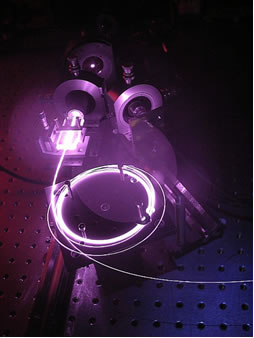Power Record for a Fiber Laser Designed for Greenhouse Gas Emission Monitoring from Space
A team from ONERA made a laser source based on optical fibers in the laboratory, which generates a 1.7 kW peak at 1580nm suitable for measuring CO2. This is a record for this wavelength that is not very favorable for fibered technology. Challenge: the monitoring of global warming from space.

Principle of spatial monitoring of atmospheric chemistry.
The laser beam emitted from the satellite is backscattered
in an atmosphere column and analyzed onboard
The monitoring of the greenhouse gas concentrations involved in global warming from space can only be done by observation satellites equipped with lidar measurement systems. These systems must meet certain qualifications: they must not be too heavy or too bulky, they must be powerful enough to perform measurements on an atmosphere column and above all must be suitable for measuring certain wavelengths that characterize the species to be measured. Here, scientists are exploring the 1580 nm wavelength, which is one of those that characterize CO2.
|
Fiber laser technology is a good candidate for space: the laser beam is powerfully amplified in an optical fiber, which is light and compact. |
|
Contact Onera : Guillaume.Canat \@/ onera.fr
